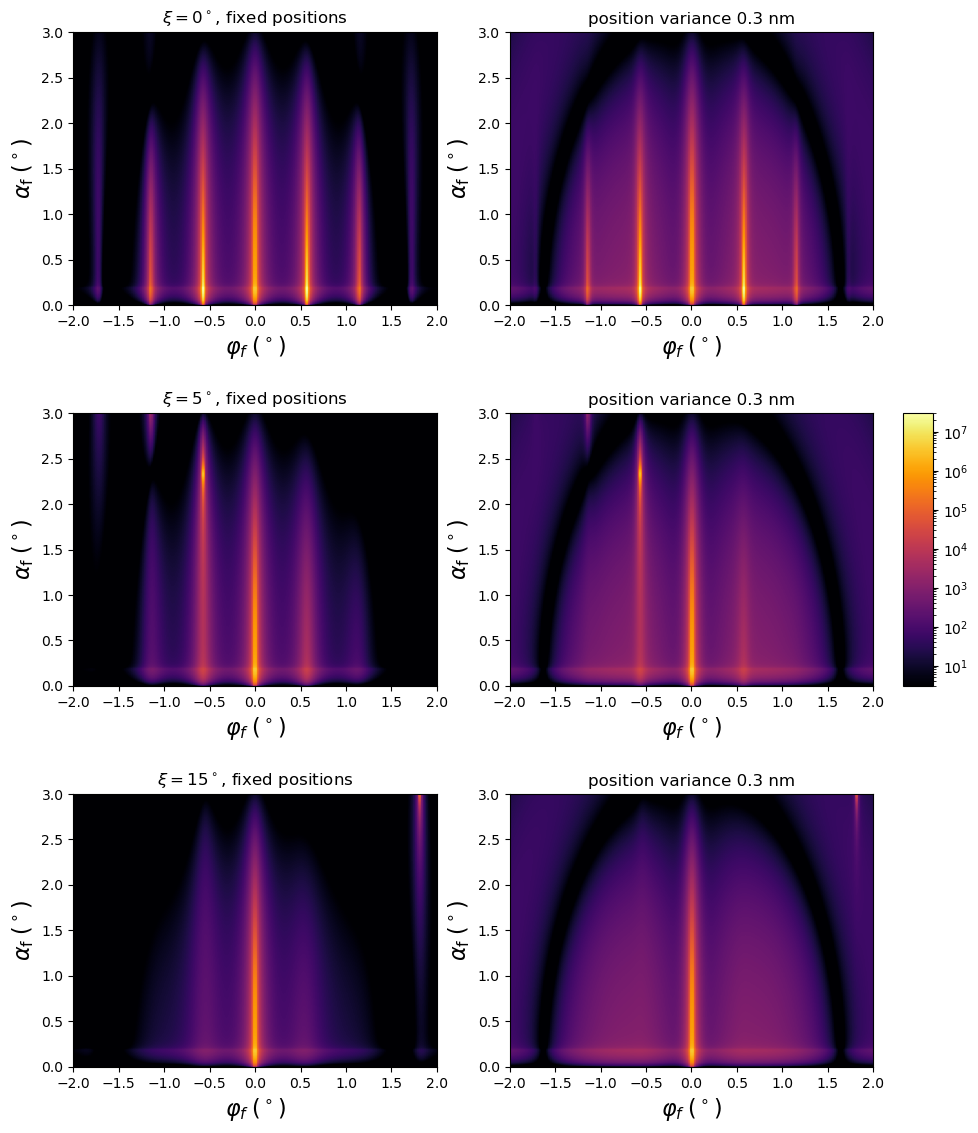1
2
3
4
5
6
7
8
9
10
11
12
13
14
15
16
17
18
19
20
21
22
23
24
25
26
27
28
29
30
31
32
33
34
35
36
37
38
39
40
41
42
43
44
45
46
47
48
49
50
51
52
53
54
55
56
57
58
59
60
61
62
63
64
65
66
67
68
69
70
71
72
73
74
75
76
77
78
79
80
81
82
83
|
#!/usr/bin/env python3
"""
"""
import bornagain as ba
from bornagain import ba_plot as bp, deg, nm
from matplotlib import pyplot as plt
def get_sample(hasVariance, xi):
# Materials
material_air = ba.RefractiveMaterial("Air", 0, 0)
material_particle = ba.RefractiveMaterial("Particle", 0.0006, 2e-08)
material_substrate = ba.RefractiveMaterial("Substrate", 6e-06, 2e-08)
# Particles
R = 2.5*nm
ff = ba.Spheroid(R, R)
particle = ba.Particle(material_particle, ff)
# Interference function
lattice = ba.SquareLattice2D(10*nm, xi)
interference = ba.Interference2DLattice(lattice)
interference_pdf = ba.Profile2DCauchy(500*nm, 500*nm, 0)
interference.setDecayFunction(interference_pdf)
if hasVariance:
interference.setPositionVariance(0.3*nm)
# Particle layout
layout = ba.ParticleLayout()
layout.addParticle(particle)
layout.setInterference(interference)
# Layers
l_air = ba.Layer(material_air)
l_air.addLayout(layout)
l_substrate = ba.Layer(material_substrate)
# Sample
sample = ba.MultiLayer()
sample.addLayer(l_air)
sample.addLayer(l_substrate)
return sample
def get_simulation(sample):
n = 200
beam = ba.Beam(1e8, 0.1*nm, 0.2*deg)
det = ba.SphericalDetector(n, -2*deg, 2*deg, n, 0, 3*deg)
return ba.ScatteringSimulation(beam, sample, det)
def run_one(hasVariance, xi, nPlot, title):
sample = get_sample(hasVariance, xi)
simulation = get_simulation(sample)
result = simulation.simulate()
plt.subplot(3, 2, nPlot)
return bp.plot_simres(result,
title=title,
intensity_max=3e7,
intensity_min=3e0,
zlabel=None,
aspect='equal',
with_cb=False)
if __name__ == '__main__':
fig, axs = plt.subplots(3, 2, figsize=(10, 13))
xi1 = 5*deg
xi2 = 15*deg
im = run_one(False, 0*deg, 1, r"$\xi=0^\circ$, fixed positions")
run_one(True, 0*deg, 2, r"position variance 0.3 nm")
run_one(False, xi1, 3, r"$\xi=5^\circ$, fixed positions")
run_one(True, xi1, 4, r"position variance 0.3 nm")
run_one(False, xi2, 5, r"$\xi=15^\circ$, fixed positions")
run_one(True, xi2, 6, r"position variance 0.3 nm")
plt.subplots_adjust(bottom=0.05, left=0.1)
plt.colorbar(im, cax=plt.axes([0.93, 0.36, 0.03, 0.21]))
bp.show_or_export()
|
 BornAgain
≻ 21
≻ Documentation ≻ Reference ≻ Sample model ≻ Particle assemblies ≻ 2D lattice ≻ Position variance
BornAgain
≻ 21
≻ Documentation ≻ Reference ≻ Sample model ≻ Particle assemblies ≻ 2D lattice ≻ Position variance
